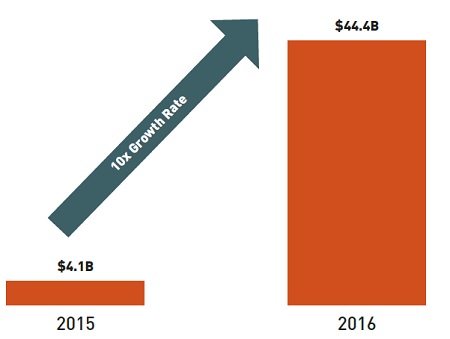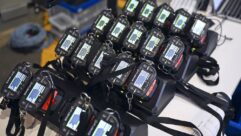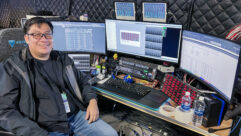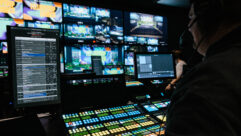

Beacon technology solutions are helping to create an ecosystem that connects brands, advertisers, mobile apps, retailers, and venues to facilitate the delivery of contextually relevant content and advertising. Moreover, beacons bridge the digital and physical worlds. Given the range of its applicability as well as its ability to drive sales and content delivery, beacon technology is poised to transform how companies interact with consumers.
Beacons use Bluetooth technology to communicate with a smartphone or other smart device in a physical environment, which can include retail stores, sports and entertainment venues, transportation hubs, parking structures, museums, and parks. When a smartphone user enters a location in which beacons are installed, a notification is sent to his/her smartphone delivering relevant, proximity-based information. For example, upon entering a retail store, the user may be informed of sales and promotions in progress at that store, in addition to live inventory data and where exactly within the store items can be located. In an art gallery, a notification may include artist information and price details on displayed works. At the airport, beacons can be used to send gate information and flight updates.
Beacons have a role to play in a number of industries. It’s about the connection to the consumer and the ability to exchange information. Digital signage use in retail outlets is expected to grow from $6 billion in 2013 to $28 billion in 2018 as retailers digitize their customer buying experience. U.S. in-store retail sales influenced by beacon-triggered messages are estimated to grow from $4.1 billion this year to $44.4 billion in 20161.
LOCATION-BASED MARKETING
Innovative retailers and marketing professionals are leveraging beacons for location-based marketing to provide consumers with push notifications—messages or alerts delivered on the location’s network to a smart device—that include contextually relevant content and offers at the point of sale. Beacons offer the unique ability to reach consumers in a purchase mindset. Brands are no longer limited by shelf displays to interact with consumers. Using beacons, store displays become an interactive and highly personalized marketing tool.
Locations deploying beacon technology can take many forms. Beacons can be placed in any physical location, as well as on or in almost any physical object, including jukeboxes, bus benches, taxis, gas pumps, ATMs, even store mannequins. By 2018, there could be as many as 300 million beacons deployed worldwide2.

Beacons can be placed on things like jukeboxes, bus benches, taxi screens, gas pump screens, ATMs, and parking and transportation signage.
MEASUREMENT AND CONVERSION, INSTORE AND BEYOND
Beacons are one of the latest mechanisms to provide analytics and targeting capabilities to physical locations. Retailers can use beacons to perform store analytics such as storefront conversions3, display-specific foot-traffic, visit duration, and visit frequency.
In the case of out-of-home (OOH) media, beacons can be installed on digital signage, billboards, and other displays to measure whether and for how long such displays were viewed. Beacons can also be deployed to deliver smart device ad retargeting or messages and then to track whether actions, if any, were taken following receipt of such messages.
Measurement metrics include:
● Impressions: “How many visitors see the display and/or visit the store?”
● Duration: “For how long does a potential consumer stand in range of the display or how much time does the consumer spend in the store?”
● Frequency: “How frequently do people visit the display or store?”
● New vs. Repeat Impressions: “What percentage of visitors are new? What percentage has visited previously?”
Out-of-home media conversion measures the percentage of people exposed to an OOH media advertisement that then proceed to visit the advertised store or specific location.
BEACON TECHNOLOGY APPLICATIONS
Up-selling: Brands can effectively attach digital information regarding product features where items are displayed, enabling consumers to make better product decisions at the point of sale and/or purchase higher margin premium products.
Cross-promoting: Brand marketers are using beacons to provide “push notifications,” promoting relevant nearby offers. For instance, a beacon placed in the women’s swimsuit department can “push” relevant accessories, e.g., sunglasses and hats.
Brand building: Beacon technology provides solutions for businesses to use physical location and advertising to engage and interact directly with consumers. Macy’s beacon program, for example, includes personalized welcome messages, images, videos and rewards programs. Without an intermediary, businesses eliminate message distortion and possess control and ownership over such distributed content and advertising.
CONSIDERATIONS
Privacy Protection: To receive push notifications and smart device advertising, users must first opt-in to receiving beacon notifications, ensuring marketers reach a receptive audience. At any point in time, users may elect to disable receiving beacon notifications, ensuring users complete control over notifications and privacy preferences. It should also be noted that in order to maintain a receptive audience, brands should be attentive to the frequency and content of their push messaging so as not to create notification fatigue in subscribers.
Closed Network Information Distribution: Martin Outdoor Media recently announced a limited pilot program with the City of Los Angeles to determine ways beacon technology can provide timely and personal proximity-based information to residents and visitors. A secure, closed network of beacons was attached to a small percentage of bus benches throughout the city. Information available to smart device users, who opt-in, include transit solutions, traffic updates, emergency services, tourist attractions, points of interest, and retail deals.
THE FUTURE IS LOCATIONSPECIFIC CONVERSION
We believe that content and marketing will continue to evolve to engage targeted mobile audiences. Retailers, advertisers, and visual communications solutions providers who generate data by targeting mobile audiences in realtime will be able to measure whether and to what extent consumers are engaging with content and marketing, which can be harnessed to drive revenue.
With the ongoing rise of the connected mobile consumer, we anticipate that proximity solutions technology will continue to evolve at a rapid pace. As the integration of beacons is gaining momentum, a new proximity channel is emerging: smart lights, which use LED lights to track the location of a shopper through sensors and deliver push notifications to the user’s mobile device. Regardless of the method, the demand is there and retailers and OOH media networks successfully integrating proximity-based technologies stand to benefit greatly—or risk losing retail and media market share.
Peter J. Solomon Company is a member of the Digital Signage Federation, the only independent, not-for-profit trade organization serving the digital signage industry. The DSF supports and promotes the common business interests of worldwide digital signage, interactive technologies and digital out-of-home network industries. To learn more, go to www.digitalsignagefederation.org.
Author Mark Boidman is a managing director and member of the media, entertainment, communications and technology group at Peter J. Solomon Company, a leading private investment banking advisory firm. He advises companies across the media and technology sectors, including digital media, marketing services, mobile, and out-of-home media. He sits on the board of directors of the Digital Signage Federation, the trade association supporting the business interests of the interactive technologies, digital signage, and digital out-of-home network industries. He is also a member of the advisory board of Gimbal, a location and proximity-based mobile engagement company.
1Source: Wall Street Research. Note: Top 100 U.S. retail locations only.
2Source: ABI Research, BLE Tags and the Location of Things, Q3 2014.
3Storefront conversions refer to the percentage of people who visit a store after exposure to a store front beacon “push notification”.







